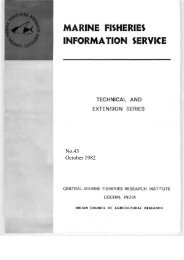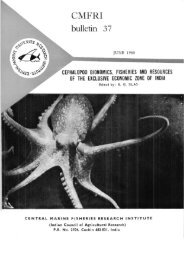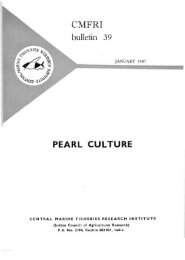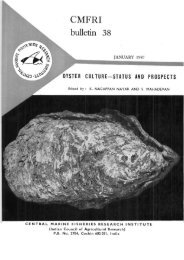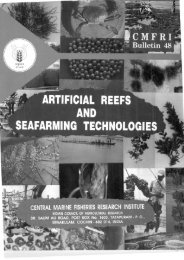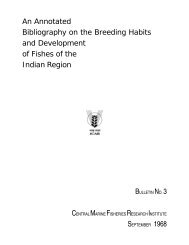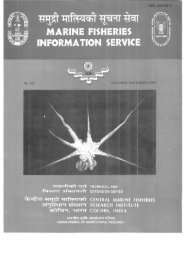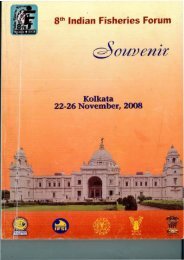PDF - Eprints@CMFRI
PDF - Eprints@CMFRI
PDF - Eprints@CMFRI
Create successful ePaper yourself
Turn your PDF publications into a flip-book with our unique Google optimized e-Paper software.
details of the potential area under aquaculture and the production in the selected States are presented intable 8. .Table 8: Potential area under aquaculture in the selected statesDetails Andhra Pradesh Karnataka Kerala Tamilnadu TotalArea under culture (hect) 62593 500000 65213 370790 998596Total production (tones) 44856 264000 54000 114089 476945Rate of production/ha (t) 0.72 0.53 0.83 0.31 0.48Total area of 9,98,596 hectare is potentially avaIlable for aquaculture and a total production of4,76,945 tones ;s recorded In the study area. Kamataka has the maximum potential area, and recordedthe maximum production among the four states 0 the study area. The rate of produotion roughly workedout for these four stafes indicates that Kerals ra nks (5t followed by Andhra Pradesh, Kamataka andTamj[nadu. The over all production rate is. only OA8 t P r ha whic is very low and there IS brightprospects for fish production through aquacullure in these states throug'h approprialte eco-friendlymethods.PART IIDetails of the Villages Selected for the StudyIn this section, the details regarding the selection of the sample districts, villages and householdsc;re discussed. Besides the results of the preliminary survey conducted is also described.4.1 Selection of districts and villagesThe selection of districts for each State was decided during the first interaction meeting of theresearch project Team. It was decided to have four districts in A.P, two in Karnataka, three in Kerala andfour in TamilnaduThe 'districts were selected based on their relative importance with respect to fishing in therespective States. From the selected districts, the villages were selected, again based on theirimportance in fishing and giving representation to all the three sectors of fishery namely-Mechanised,Motorised and Non-mechanised. For ,example in North Tamilnadu, Pudmanaikuppam In Chennai is apredominantly a mechnised fishing village, Kovalam is a mortised fishing village and Pulicut is a nonmechanisedfishing village. In South Tamilnadu, Thirespuram in Tuticorin is a mechanized fishing village,Punnakayat is motorized and Tharuvaikulam is a nonmechflaised fishing villages. The detaJis of thenumber of districts and villag!3s selected are presented in table 9.Table 9: Details of the selected villagesState No. of dist. No. of vii/ages No. of householdsCovered covered coveredAndhrapradesh 4 (30.8) 9 (33.3) 1800 (31.3)Karnataka I 2 (15.4) 8 (26.0) 1008 (17.8)Kerala 3 (23.0) 5 (18.5) 1255(21.8)Tamilnadu 4 (30.8) 6 (22.2) 1681 (29.3)Total 13 (100.0) 28 (100.0) 5744 (100.0)Note: Figures In parenthesIs are percentagesThe survey was conducted in 1800 households covering 9 villages of the 4 distrIcts selected inAndhra Pradesh, 1008 h:ol.ls.eholds covering 7 virrages in 2 dfstri·ets 'in Kamataka, 1255 households in the5 villages covering 3 districts in Kerala and 1681 households of 6 selected villages of the 4 districts inTamilnadu.4.2 Objectives for selection of villagesThe villages for the study were selected based on the objectives and the different stakeholders inthe coastal eco-system involving fisherwomen. Representations were given to mechanized, motorizedIS




